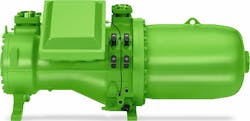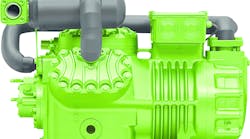Following an extensive qualification program, compressor specialist Bitzer has announced approval of the R1234yf and R1234ze(E) HFO refrigerants for its CSH and CSW screw compressors. The two alternatives to R134a have a global warming potential (GWP) of under ten, while the GWP of R134a is around 1,400. With a GWP of about 600 each, the HFO/HFC blends R513A and R450A are also approved for the CSH and CSW series. Unlike the pure HFO refrigerants, they’re nonflammable.
The requirements stipulated by the EU’s F-gas Regulation no. 517/2014 also represent a huge challenge for manufacturers of refrigeration compressors. In order to meet the phase-down objectives, alternative refrigerants such as hydrofluoroolefins (HFOs) will have to be used in the future. The volumetric refrigerating capacity and pressure levels of R1234yf are comparable with those of R134a, while the capacity figures and pressure levels of R1234ze(E) are around 20 to 25% lower. BITZER subjected the R1234yf and R1234ze(E) refrigerants in this group to intensive testing, and the compressors performed well with both in all of the tests and laboratory experiments. The tested compressors achieved nearly identical isentropic efficiency values with R1234yf and R1234ze(E) as with R134a. Due to differences in the thermodynamic properties, the COP measurement results are in some cases slightly lower.
Both of the HFOs are suitable for air conditioning and medium temperature applications in particular, as well as for heat pumps. There’s often a degree of uncertainty regarding flammability. In safety data sheets, R1234ze(E) is listed as nonflammable, though this only applies to transport and storage. When used as a refrigerant, a higher reference temperature of 60°C (140°F) is applied in flammability tests. At this temperature, R1234ze(E) is flammable and therefore assigned to the A2L safety group, just like R1234yf. For this reason, a risk assessment in accordance with the ATEX Directive is required for systems with both refrigerants — with potential consequences in the system design. Bitzer compressors for HFO refrigerant fulfill the relevant requirements, making additional evaluation unnecessary.
HFO/HFC blends such as R513A and R450A, on the other hand, are nonflammable and therefore classified in the A1 safety group. Using them requires nothing more than a conventional risk assessment in accordance with the Machinery Directive. However, the substitutes R513A and R450A have a GWP of around 600.
After evaluating all of the results, Bitzer has announced approval of the HFO refrigerants R1234yf and R1234ze(E) and the HFO/HFC blends for CSH and CSW compact screw compressors. These tried-and-tested products can be operated with the standard ester oil charge (Y-model) with HFO refrigerants in the documented applications.
CSH and CSW: high energy efficiency
The universal CSH and CSWcompact screw compressors can also be used with the economizer circuit to further increase refrigerating capacity and efficiency. They’re fitted with dual capacity control and can be adjusted infinitely or according to scale. The level of energy efficiency is a benchmark in this compressor technology in both full-load and part-load operation.
CSH compressors demonstrate their strength particularly in air cooled liquid chillers for comfort air conditioning and in heat pumps. The CSW series is suitable for use in liquid chillers operated at low condensing temperatures. The compressors are used in systems with water cooled condensers, process cooling and systems with air cooled condensers operating under moderate climatic conditions.





